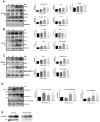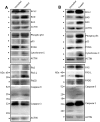Novel levamisole derivative induces extrinsic pathway of apoptosis in cancer cells and inhibits tumor progression in mice
- PMID: 22970136
- PMCID: PMC3438185
- DOI: 10.1371/journal.pone.0043632
Novel levamisole derivative induces extrinsic pathway of apoptosis in cancer cells and inhibits tumor progression in mice
Abstract
Background: Levamisole, an imidazo(2,1-b)thiazole derivative, has been reported to be a potential antitumor agent. In the present study, we have investigated the mechanism of action of one of the recently identified analogues, 4a (2-benzyl-6-(4'-fluorophenyl)-5-thiocyanato-imidazo[2,1-b][1], [3], [4]thiadiazole).
Materials and methods: ROS production and expression of various apoptotic proteins were measured following 4a treatment in leukemia cell lines. Tumor animal models were used to evaluate the effect of 4a in comparison with Levamisole on progression of breast adenocarcinoma and survival. Immunohistochemistry and western blotting studies were performed to understand the mechanism of 4a action both ex vivo and in vivo.
Results: We have determined the IC(50) value of 4a in many leukemic and breast cancer cell lines and found CEM cells most sensitive (IC(50) 5 µM). Results showed that 4a treatment leads to the accumulation of ROS. Western blot analysis showed upregulation of pro-apoptotic proteins t-BID and BAX, upon treatment with 4a. Besides, dose-dependent activation of p53 along with FAS, FAS-L, and cleavage of CASPASE-8 suggest that it induces death receptor mediated apoptotic pathway in CEM cells. More importantly, we observed a reduction in tumor growth and significant increase in survival upon oral administration of 4a (20 mg/kg, six doses) in mice. In comparison, 4a was found to be more potent than its parental analogue Levamisole based on both ex vivo and in vivo studies. Further, immunohistochemistry and western blotting studies indicate that 4a treatment led to abrogation of tumor cell proliferation and activation of apoptosis by the extrinsic pathway even in animal models.
Conclusion: Thus, our results suggest that 4a could be used as a potent chemotherapeutic agent.
Conflict of interest statement
Figures









Similar articles
-
Synthesis and biological evaluation of novel 2-aralkyl-5-substituted-6-(4'-fluorophenyl)-imidazo[2,1-b][1,3,4]thiadiazole derivatives as potent anticancer agents.Eur J Med Chem. 2011 Jun;46(6):2109-16. doi: 10.1016/j.ejmech.2011.02.064. Epub 2011 Mar 4. Eur J Med Chem. 2011. PMID: 21439690
-
A novel cinnamide YLT26 induces breast cancer cells apoptosis via ROS-mitochondrial apoptotic pathway in vitro and inhibits lung metastasis in vivo.Cell Physiol Biochem. 2014;34(6):1863-76. doi: 10.1159/000366385. Epub 2014 Nov 21. Cell Physiol Biochem. 2014. PMID: 25503322
-
An anthraquinone derivative from Luffa acutangula induces apoptosis in human lung cancer cell line NCI-H460 through p53-dependent pathway.J Recept Signal Transduct Res. 2016;36(3):292-302. doi: 10.3109/10799893.2015.1108335. Epub 2015 Nov 20. J Recept Signal Transduct Res. 2016. PMID: 26585176
-
Selective activation of TNFR1 and NF-κB inhibition by a novel biyouyanagin analogue promotes apoptosis in acute leukemia cells.BMC Cancer. 2016 Apr 20;16:279. doi: 10.1186/s12885-016-2310-5. BMC Cancer. 2016. PMID: 27098354 Free PMC article.
-
A Natural Quinazoline Derivative from Marine Sponge Hyrtios erectus Induces Apoptosis of Breast Cancer Cells via ROS Production and Intrinsic or Extrinsic Apoptosis Pathways.Mar Drugs. 2019 Nov 23;17(12):658. doi: 10.3390/md17120658. Mar Drugs. 2019. PMID: 31771152 Free PMC article.
Cited by
-
Curcumin derivative 1, 2-bis [(3E, 5E)-3, 5-bis [(2-chlorophenyl) methylene]-4-oxo-1-piperidyl] ethane-1, 2-dione (ST03) induces mitochondria mediated apoptosis in ovarian cancer cells and inhibits tumor progression in EAC mouse model.Transl Oncol. 2022 Jan;15(1):101280. doi: 10.1016/j.tranon.2021.101280. Epub 2021 Nov 19. Transl Oncol. 2022. PMID: 34801859 Free PMC article.
-
Transcriptome profiling reveals that VNPP433-3β, the lead next-generation galeterone analog inhibits prostate cancer stem cells by downregulating epithelial-mesenchymal transition and stem cell markers.Mol Carcinog. 2022 Jul;61(7):643-654. doi: 10.1002/mc.23406. Epub 2022 May 5. Mol Carcinog. 2022. PMID: 35512605 Free PMC article.
-
Identification of antiparasitic drug targets using a multi-omics workflow in the acanthocephalan model.BMC Genomics. 2022 Sep 30;23(1):677. doi: 10.1186/s12864-022-08882-1. BMC Genomics. 2022. PMID: 36180835 Free PMC article.
-
Synthesis, Molecular Docking and Preliminary Antileukemic Activity of 4-Methoxybenzyl Derivatives Bearing Imidazo[2,1-b][1,3,4]thiadiazole.Chem Biodivers. 2021 Feb;18(2):e2000800. doi: 10.1002/cbdv.202000800. Epub 2021 Jan 7. Chem Biodivers. 2021. PMID: 33274824 Free PMC article.
-
In vitro evaluation of p-coumaric acid and naringin combination in human epidermoid carcinoma cell line (A431).Med Oncol. 2023 Nov 29;41(1):4. doi: 10.1007/s12032-023-02230-3. Med Oncol. 2023. PMID: 38019336
References
-
- Nambiar M, Kari V, Raghavan SC (2008) Chromosomal translocations in cancer. Biochim Biophys Acta 1786: 139–152. - PubMed
-
- Aplan PD (2005) “You break it, you fix it.”. Blood 105: 1843–1844. - PubMed
-
- Rowley JD (2001) Chromosome translocations: dangerous liaisons revisited. Nat Rev Cancer 1: 245–250. - PubMed
Publication types
MeSH terms
Substances
LinkOut - more resources
Full Text Sources
Research Materials
Miscellaneous

